

- #Fire sprinkler system design plan view how to#
- #Fire sprinkler system design plan view upgrade#
- #Fire sprinkler system design plan view code#
Even within a single facility, there may be different code and insurance requirements for various zones, based on their function. Requirements for a hospital will be drastically different than those that apply to a commercial office building or elementary school. In addition, check the existing city water flow and pressure by contacting the authority having jurisdiction (AHJ) for a current hydrant flow test, indicating maximum flow, and residual and static pressures prior to upsizing the fire water service.Ī variety of factors will determine a building’s code and insurance requirements, including the type of facility and its ownership.
#Fire sprinkler system design plan view how to#
Is the fire water service the correct size for current building code? Is the backflow preventer a “non-slamming” type valve? Does the current code require a combined domestic/fire water service or a dedicated fire service? If the fire water service is determined not to be code compliant, then consult a civil engineer for where the existing city mains are located and how to connect. Lastly, don’t forget to access the incoming water service and type of backflow preventer valve.Are these tanks still required? What is their current condition? Are they wood or steel? Can the tanks be removed? Older, high-rise buildings may have 15,000 or more gallon fire water supply tanks in the penthouse.Do floor control zone valves and other system control valves have electronic tamper switches or just locks and chains?.Most authorities having jurisdiction do not want occupants to fight a fire instead they want all occupants to evacuate the building as quickly as possible and move away from the building to a designated safe location a few blocks away. Do the standpipes have 1½-inch flexible hoses attached? These hoses are for occupant use during a fire.Are the stairwells fully sprinklered? Where is the fire pump test header located? The annual fire pump test will flow anywhere between 500 and 1,500 gpm, which is a lot of water to flow around the building. Was the fire suppression system designed correctly? Does it have proper gallons per minute (gpm), zoning, pressure rating?.Consider zoning usage by floor or department to match the building layout. Similarly, hospitals will require different types of fire suppression zoning based on the programing of each floor. What is the program for floor usage? A mission critical space with servers will not allow a wet fire protection system, therefore a mist or fog system would be ideal.Are the fire pump and pump controllers up to date? Are they connected to the building generator? Typically, in an aging building, they are not.Are the existing sprinkler heads code-compliant “quick-response” heads? With wood, for example, additional sprinklers are required in the ceiling spaces and in the drywall ceiling below. What’s the interior composition of the building? The type of system required will be based on the building’s construction.Is it a partially or fully sprinklered system? Buildings 40-years-old or more will typically have only a partial wet fire protection system, or simply just fire department standpipes.A thorough assessment will answer the following questions: The walk-through will reveal the age of the system if it is wet, dry or a mixture of both and the location of all major sprinkler equipment. This is critical in older buildings where additions have been made throughout the years, and previous fire system upgrades weren’t done in tandem.

The fire system assessment requires an on-site walk through that affords the consulting fire protection engineer an opportunity to visually discover the existing fire protection system and its features.
#Fire sprinkler system design plan view upgrade#
Whether a building is gearing up for a fire system upgrade to meet code requirements, or it is part of a larger infrastructure renovation, or the goal is satisfying insurance requirements, three steps can serve as a map for any fire system upgrade. What’s more, many local and state fire protection codes have been updated in the last decade, often requiring sprinkling beyond just the “path of egress” (lobby and stairwell areas), and now requiring sprinkling into the offices and interior rooms of commercial buildings. For example, today’s fire suppression systems have significantly faster response times than those on the market just 20 years ago. And 50-year-old systems, while they may still be code compliant, may not match the capabilities of newer equipment. Fire pumps have a life span of 50 years, but only if properly maintained and annually tested. After 50-plus years of service, UL Laboratories requires sprinklers to be taken out and sent back for testing and re-certification. But there’s a good chance it’s not up to date.


 0 kommentar(er)
0 kommentar(er)
